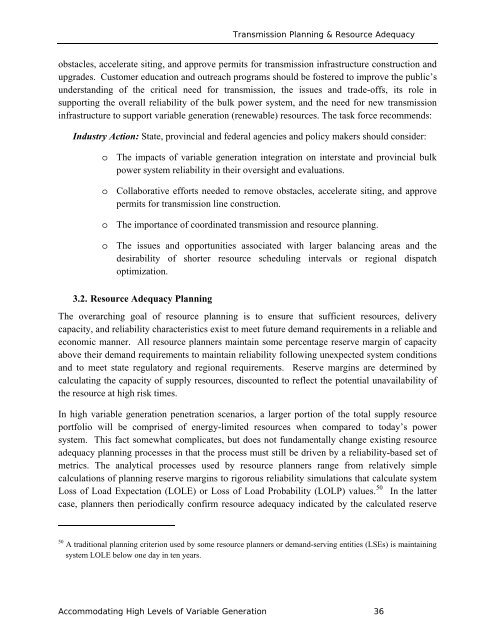Accommodating High Levels of Variable Generation - NERC
Accommodating High Levels of Variable Generation - NERC
Accommodating High Levels of Variable Generation - NERC
You also want an ePaper? Increase the reach of your titles
YUMPU automatically turns print PDFs into web optimized ePapers that Google loves.
Transmission Planning & Resource Adequacy<br />
obstacles, accelerate siting, and approve permits for transmission infrastructure construction and<br />
upgrades. Customer education and outreach programs should be fostered to improve the public’s<br />
understanding <strong>of</strong> the critical need for transmission, the issues and trade-<strong>of</strong>fs, its role in<br />
supporting the overall reliability <strong>of</strong> the bulk power system, and the need for new transmission<br />
infrastructure to support variable generation (renewable) resources. The task force recommends:<br />
Industry Action: State, provincial and federal agencies and policy makers should consider:<br />
o The impacts <strong>of</strong> variable generation integration on interstate and provincial bulk<br />
power system reliability in their oversight and evaluations.<br />
o Collaborative efforts needed to remove obstacles, accelerate siting, and approve<br />
permits for transmission line construction.<br />
o The importance <strong>of</strong> coordinated transmission and resource planning.<br />
o The issues and opportunities associated with larger balancing areas and the<br />
desirability <strong>of</strong> shorter resource scheduling intervals or regional dispatch<br />
optimization.<br />
3.2. Resource Adequacy Planning<br />
The overarching goal <strong>of</strong> resource planning is to ensure that sufficient resources, delivery<br />
capacity, and reliability characteristics exist to meet future demand requirements in a reliable and<br />
economic manner. All resource planners maintain some percentage reserve margin <strong>of</strong> capacity<br />
above their demand requirements to maintain reliability following unexpected system conditions<br />
and to meet state regulatory and regional requirements. Reserve margins are determined by<br />
calculating the capacity <strong>of</strong> supply resources, discounted to reflect the potential unavailability <strong>of</strong><br />
the resource at high risk times.<br />
In high variable generation penetration scenarios, a larger portion <strong>of</strong> the total supply resource<br />
portfolio will be comprised <strong>of</strong> energy-limited resources when compared to today’s power<br />
system. This fact somewhat complicates, but does not fundamentally change existing resource<br />
adequacy planning processes in that the process must still be driven by a reliability-based set <strong>of</strong><br />
metrics. The analytical processes used by resource planners range from relatively simple<br />
calculations <strong>of</strong> planning reserve margins to rigorous reliability simulations that calculate system<br />
Loss <strong>of</strong> Load Expectation (LOLE) or Loss <strong>of</strong> Load Probability (LOLP) values. 50 In the latter<br />
case, planners then periodically confirm resource adequacy indicated by the calculated reserve<br />
50 A traditional planning criterion used by some resource planners or demand-serving entities (LSEs) is maintaining<br />
system LOLE below one day in ten years.<br />
<strong>Accommodating</strong> <strong>High</strong> <strong>Levels</strong> <strong>of</strong> <strong>Variable</strong> <strong>Generation</strong> 36
















